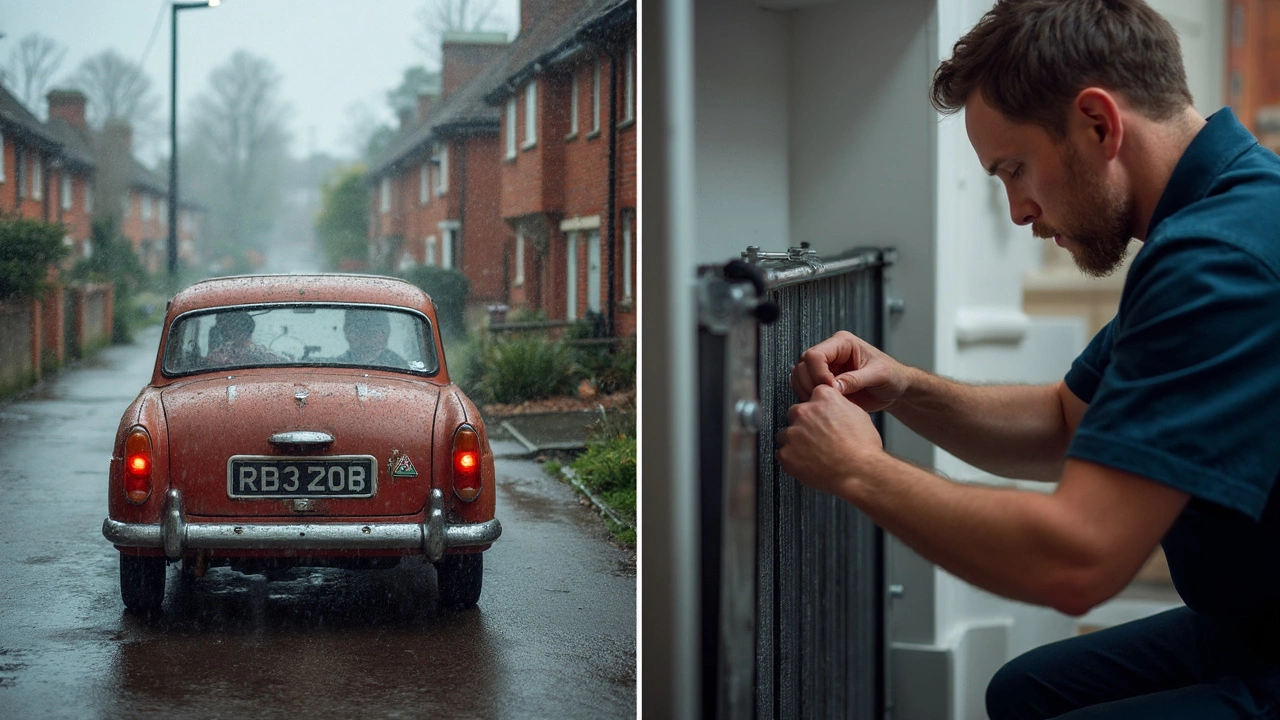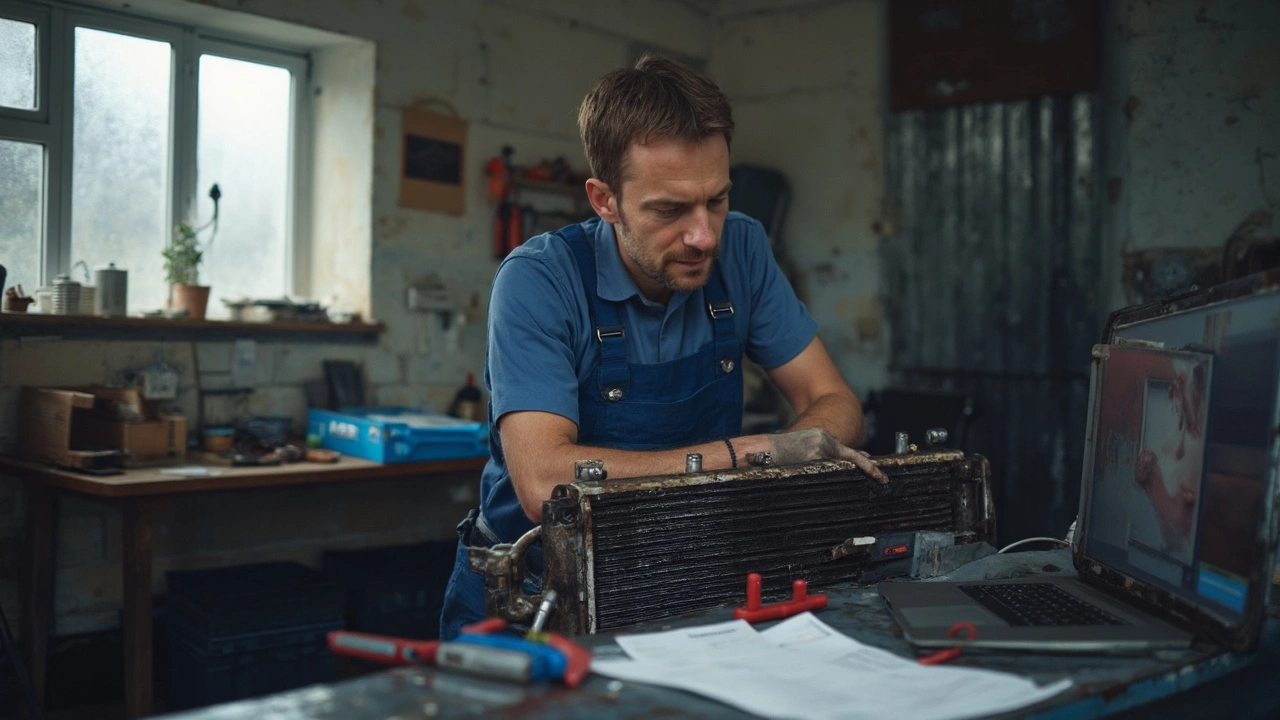Ever watched your car’s temperature needle suddenly spike and wondered if you’re about to face a fat repair bill? Radiator woes are every driver’s headache—their main job is keeping your engine from frying itself, and when they go bad, things get expensive, fast.
So, what’s actually cheaper? Fixing what you’ve got, or just swapping it out for a new one? The answer isn’t as simple as picking the cheapest option on the surface. Sometimes a quick patch-up seems like a steal—until you’re towed two weeks later, steaming on the shoulder. Other times, replacing your radiator works out way less painful for your wallet in the long run.
Don’t let the garage talk you into a big repair job you don’t need, or throw good money after bad with endless patch-ups. Get the facts before you hand over your keys. Here’s how to figure out what makes sense for your car and your budget.
- Spotting the Problem: Is Your Radiator Failing?
- Typical Costs: Repair vs Replacement
- When a Quick Fix Pays Off
- Why Replacing Makes Sense Sometimes
- DIY and Shop Choices: What to Watch For
- Smart Tips to Extend Radiator Life
Spotting the Problem: Is Your Radiator Failing?
It’s easy to brush off weird car symptoms—until you’re stranded. Catching radiator problems early gives you a shot at saving cash and stress. Most radiator trouble starts small and, if you ignore it, turns into a full-blown wallet-buster.
Keep your eyes peeled for these classic signs your car radiator is in trouble:
- Rising engine temperature: If your temp gauge creeps up, the radiator might not be doing its job. Don’t just assume it’s the summer heat.
- Puddle under the car: Green, orange, or pink liquid under the front bumper? Coolant leaks mean your radiator is losing fluid, which leads to overheating.
- Strange smells: A sweet or musty smell from the hood usually means coolant is burning or leaking.
- Low coolant warning light: If this pops up despite topping up coolant, there’s either a leak or poor circulation.
- Sludge in the reservoir: Pop the cap on your coolant tank. Milky, oily gunk? Your radiator can’t keep fluids separated anymore, which is bad news.
- Rust spots or discoloration: Rusty marks on the radiator or steam under the hood are early hints that things aren’t sealed tight.
Think these are obvious? Here’s the thing—drivers ignore these signs all the time, telling themselves, “It’s nothing.” A study from AAA shows nearly two-thirds of breakdowns are due to cooling system failures, and radiators are a top culprit. All it takes is one overheated trip and suddenly what could've been a $100 fix turns into an $800 engine meltdown.
| Warning Sign | What It Might Mean | What Could Happen Next |
|---|---|---|
| Coolant leak | Cracked hose, loose clamp, or radiator damage | Loss of cooling, engine overheats |
| Discolored coolant | Corrosion inside radiator | Clogged system, poor heat transfer |
| Steam from hood | Overheating, failed radiator cap | Major engine damage if ignored |
| Sludge in tank | Oil mixing with coolant | Sign of internal failure or blown head gasket |
Bottom line: noticing these problems early gives you choices. The longer you roll the dice, the more you pay. If you spot anything on this list, it’s time to get under the hood or hit a shop before your next drive turns into a disaster.
Typical Costs: Repair vs Replacement
When your radiator acts up, you’re probably dreading the price tag. Let’s get real about what you could pay for both repairs and replacements—not just vague “two or three hundred” fairy tales. Pricing depends on your car, the problem, and where you live, but here’s what’s actually going on out there in 2025.
First, radiator repair costs can be pretty reasonable if the issue is minor. Got a small leak? A decent shop might patch it for $100 to $250, especially if it’s just a cracked plastic tank or a leaky hose. Flushing out clogs and adding sealant falls in the same range. Bigger problems, like a full re-core or rebuilding metal parts, can spike to $350 or more.
Going for a full replacement? Expect a much wider range. If you drive a basic sedan, budget $350 to $900 including labor. Trucks, luxury brands, or imports can jump well over $1,200. You might see those tempting cheap radiators online for $100—but by the time you factor in labor, coolant, and shop fees, the real cost always climbs.
Here’s a quick breakdown to keep it simple:
| Job Type | Average Cost (Parts & Labor) |
|---|---|
| Minor Leak Repair | $100 - $250 |
| Full Re-core/Patch Major Damage | $350 - $500+ |
| Radiator Replacement (Economy Car) | $350 - $900 |
| Radiator Replacement (Truck/Luxury) | $900 - $1,400+ |
Don’t forget: there’s more at stake than dollars. Fixes like stop-leak or quick patches can get you rolling, but they might only last a few months. Replacement hurts more upfront, but for older or already-badly corroded radiators, it can save you from being stuck on the side of the road or frying your engine.
Quick tip: Always get quotes from two or three shops. Some throw in a free coolant flush, others charge extra—so it pays to ask before you give the go-ahead.
When a Quick Fix Pays Off
Not every radiator drama means you need a totally new part. Sometimes, small issues are perfectly fixable—and honestly, if you’re tight on cash or just want to keep the car going a bit longer, a quick repair can make real sense.
The trick is figuring out which problems are safe to patch up. For example, a pinhole leak from a rock chip or old seam can often be sealed up. Radiator leak sealants (liquid or pellets) cost around $10–$20. But, don’t expect miracles—they work best as a short-term fix or emergency solution, not a permanent answer.
- If your radiator has a cracked hose, replacing that hose is cheap ($15–$50) and can fix overheating right away.
- Loose clamps or connections also cost little to tighten or swap—many folks can do this at home in minutes.
- Even simple corrosion or debris stuck in the radiator fins can cause trouble, but a careful cleaning is often all you need.
Here’s a breakdown of typical repair costs:
| Repair Type | Average Cost (USD) | Expected Lifespan |
|---|---|---|
| Seal a small leak | $15 - $30 | A few weeks to months |
| Replace hose | $20 - $70 | 2–5 years |
| Flush debris | $60 - $100 | Variable |
Just remember, if your car radiator is old and looks worse for wear—like cracks in the plastic tank or rusty metal—quick fixes are more like putting a band-aid on a busted pipe. Use these repairs when you’re in a pinch or your car isn’t worth big repair bills. Otherwise, keep an eye out for recurring problems and don’t put off bigger repairs too long.
If you do go the quick fix route, pop the hood every few days and check for leaks or weird smells. Fast action after a small leak can really buy you time, especially if you’re saving up for a better fix or planning to upgrade your ride soon.

Why Replacing Makes Sense Sometimes
Here’s the plain truth: A car radiator isn’t built to last forever, and sometimes, no amount of repairs will make it act brand new. You have to look at things honestly—is the radiator patched up so much it resembles Frankenstein, or is it on its first hiccup?
If you keep seeing leaks, overheating, or you’ve already shelled out for a couple repairs in one year, you’re probably throwing money away. The real cost piles up when you keep fixing the same old problem. Modern radiators, especially plastic ones, aren’t made for endless repairs anyway—patches won’t hold when the plastic tanks crack for good.
And check this out: According to recent data, the average radiator repair runs $100-$300 for minor stuff, but a full replacement usually costs $400-$900 at a shop, including parts and labor. If you’re paying more than half the price of a new one just to fix the old thing, it rarely pays off.
There are a few situations where replacement is the best option:
- The radiator is over 7 years old (most only last 8–10 years with normal use).
- You see rust everywhere, especially inside. Rust can’t be patched—it slowly eats away at everything.
- You’ve got multiple leaks or damage around the seams. Quick fixes just don’t stick.
- The *car radiator* is clogged so bad that flushing doesn’t clear it up—this kills your coolant flow and risks engine damage.
Let’s look at a quick breakdown of repair costs versus replacement if you’re still on the fence:
| Issue | Repair Cost (avg.) | Replacement Cost (avg.) |
|---|---|---|
| Minor Leak (hose, clamp, gasket) | $100–$200 | $400–$900 |
| Plastic Tank Crack | $150–$300 | $400–$900 |
| Severe Corrosion/Multiple Leaks | $200+ (often recurring) | $400–$900 |
Paying for a brand new radiator means no more worrying about sudden breakdowns or patch jobs failing. Most replacements come with a warranty, too, which is worth it if you rely on your ride for daily driving or road trips.
DIY and Shop Choices: What to Watch For
Thinking about fixing a busted radiator yourself? Some jobs, like swapping out cracked hoses or a bad cap, aren’t rocket science. But if you’re eyeing a full radiator replacement, things get messy fast—especially on newer cars with packed engine bays or those plastic tanks glued in tight. Before you grab your toolbox, make sure you know exactly where the leaks are coming from. Sometimes it’s just a loose clamp or a worn hose, and you can save cash doing those at home with basic tools.
If you want to try a DIY fix, pop the hood only after the engine cools off (seriously, hot coolant can burn you bad). Drain the coolant into a clean catch pan if you’re removing the radiator, and keep pets away—coolant tastes sweet, but it’s toxic. Take pictures before you start pulling anything apart, so you can hook everything back up right. And always use the right coolant for your make—it matters more than you’d think.
But when you’re looking at a cracked radiator core or big metal damage, this isn’t a job for cheap sealants you grabbed off a shelf. Sure, stop-leak stuff can help in a pinch, but it’s rarely a real fix and sometimes just gums up the system worse. One study from 2022 found these additives clogged heater cores in about 38% of cars tested. If your car radiator has serious rust or it’s leaking from more than one spot, get a shop to take a look—especially if your daily ride is your only way to work.
At the shop, always ask if they’ll use an OEM (original equipment) part or an aftermarket one. OEMs usually last longer, but some aftermarket radiators fit poorly or have thinner metal that wears out quick. Ask to see the old part after the swap—scammy shops do exist. And don’t forget to ask about a warranty on parts and labor. A good warranty means the place trusts their work, and that peace of mind is worth a few extra bucks.
If a shop quotes you a replacement and it’s almost as much as your car is worth, ask about repair options or even a used part from a local salvage yard. Sometimes, a clean used radiator with low mileage can keep you rolling without draining your bank account. Whichever way you go, don’t just shop by price—go by reputation and by how well they answer your questions. Your car (and your wallet) deserve it.
Smart Tips to Extend Radiator Life
If you’re tired of surprise bills and want your car radiator to last, a bit of attention goes a long way. Good habits make a bigger difference than most people think. Let’s look at what actually keeps radiators going and what’s just a waste of time.
- Flush the coolant regularly. Stale coolant gets full of rust and gunk, which clogs the radiator. Most car manuals recommend flushing the radiator every 2 to 3 years, but if you drive in tough conditions—like stop-and-go traffic or dusty areas—flushing yearly won’t hurt.
- Check coolant levels every month. Low levels usually mean a leak. Catch it early, and you dodge a bigger repair bill.
- Inspect hoses and clamps all the time. Hoses crack and clamps loosen with age. If you see a wet spot under your car or dried coolant on a hose, don’t wait around—fix it before it gets ugly.
- Use the right coolant blend. Not all coolants are created equal. The wrong type messes with the radiator’s metals, causing leaks from inside out. Stick with what your car’s manual calls for.
- Don’t ignore small drips or steam. Even a tiny coolant puddle can turn into a blown engine if you keep ignoring it. Better to fix a $10 clamp than a $1,000 radiator later.
Just how long can a well-cared-for radiator last? Check out this quick comparison:
| Maintenance Routine | Average Radiator Lifespan |
|---|---|
| Neglected (no coolant flush, poor checks) | 3-5 years |
| Basic care (yearly flush, regular checks) | 8-10 years |
| Excellent care (perfect schedule, prompt repairs) | 12+ years |
One more thing: keep an eye on your temperature gauge every time you drive. Modern cars have warning lights, but by the time they’re flashing, you’re already in trouble. If it creeps up, pull over—don’t risk a meltdown just to save a few minutes.

